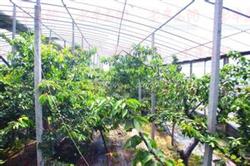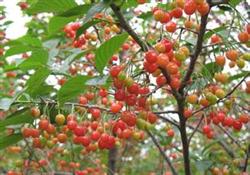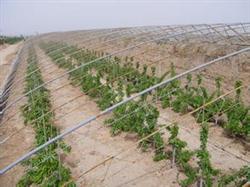There are ten ways to manage Big Cherry in summer.

First, pull branches and open corners. Winter pruning can not solve the ventilation and light transmission conditions of the tree at one time. If some big trees put too much emphasis on the angle in winter pruning, they are bound to be cut off, causing unnecessary losses to the tree. The problems that can not be solved by winter shearing can be solved by pulling branches in summer, so as to reduce the amount of thinning branches. Generally, the branch opening angle is carried out after harvest in June, and the tree response is relatively mild, and it is not easy for branches to appear on the back. the angle of the main branch and side branch should be 60-70 degrees, while the other branches can be pulled to 80-90 degrees. Second, pick the heart and cut short. For the vigorous growth of the trunk to prolong the branch to pick the heart, not to pick, the competitive branch to pick the heart to control. When the trunk extension branch is 50 cm long, remove the heart and remove 10 cm. When the main branch is 40 cm long, remove 10 cm (leaving buds), and leave 10 cm to pick the heart of the upright branch that grows after coring. From late May to early June, the erect branches or overstrong lateral branches were trimmed (3 large leaves were left at the base to be cut off), and some strong strips could be cut twice in a row. Third, branch thinning and retraction. Summer branch thinning is usually carried out from late May to early June after fruit harvest (the best thinning is in July). Its purpose is to remove the overlapping, upright, too dense, too strong and seriously affect the light of perennial branches, in order to improve the ventilation and light transmission conditions of the inner chamber of the crown, balance the tree potential, easy to heal the thinning wound after fruit picking, and weaken the tree potential slightly. For the large branches which only affect the local light conditions, but have a certain fruiting ability, they can be shrunk to weak branches. Fourth, twist the top and get the branch. Twist the shoot when the new shoot is not lignified from late May to early June, and gently twist the erect branch, competitive branch and introverted temporary branch about 5 cm from the base of the branch, which is beneficial to the formation of flower bud. In the middle and last ten days of July, the middle and upper one-year-old branches softened continuously for 2 or 3 times, the opening angle weakened the apical dominance, weakened the growth potential, which was beneficial to the formation of flower buds. Fifth, except for sprouting and ring peeling. In order to save nutrients and prevent branches from growing close, hidden buds, only growing branches or useless sprouts and shoots should be removed in early summer. At the same time, girdling of big cherry trees can promote flower bud formation, improve flower fruit setting rate and fruit quality, but after girdling of big cherry trees, the wound heals slowly, and the width of girdling should not exceed 0.5 cm, and because of the different tree potential of big cherries, especially the trees with less organic fertilizer, it is easy to flow glue, so it should be used cautiously in production. Sixth, watering at the right time. Sweet cherries are neither resistant to drought nor waterlogging. On the other hand, Rain Water in the north is not uniform. On the basis of watering pre-flowering water in early spring, such as summer drought, hard core water, pre-harvest water and post-harvest water should be well watered. According to the law of Rain Water in the north, attention should be paid to drought prevention and timely irrigation according to soil moisture in late June, while drainage and waterlogging should be done well in the rainy season from July to August. 7. Apply paclobutrazol. For 3-year-old Wangda cherry trees, paclobutrazol was applied in late April and mid-June in Shandong, Henan and other places, with 5 grams per tree. According to the experiment, the effect of soil application of paclobutrazol in early May was better, most of the branches were capped in the first and middle of June, and the flowering rate was 95%, while the flowering rate without paclobutrazol was only 20%. Eighth, crack prevention harvesting. Before harvest, due to watering, rainfall and heavy fog, the pulp cells expanded rapidly and all kinds of physiological activities accelerated, but the physiological activities of pericarp cells were relatively slow. when the swelling pressure of the fruit increases to more than the pressure that the peel and pulp cell wall can bear, it will cause fruit cracking. Pre-harvest fruit cracking is often closely related to fruit calcium deficiency, and calcium supplement is an important measure to prevent preharvest fruit cracking of big cherry. The method of calcium supplement is: starting from about two weeks after anthesis, spraying 300 times 500 times of amino acid calcium every 10 days, or 150 times calcium hydroxide solution and 100 times calcium chloride solution, a total of 2 times 3 times, can significantly reduce fruit cracking. The harvest time is determined comprehensively according to the fruit maturity, use and market demand, and the varieties with inconsistent maturity should be harvested by stages. 9. Reasonable topdressing. Immediately after fruit harvest, quick-acting fertilizer, preferably compound fertilizer, 0.2-0.3 kg per plant, was applied to promote flower bud differentiation. Prevention and control of diseases and insect pests. The main diseases and insect pests that harm cherries in summer are gummy disease, mulberry scale, bridge worm and peach leaf moth. ① glue disease, in the initial stage of glue flow, use a knife to cut a few knives in the spot to extrude juice, and then brush stone sulfur mixture has a certain effect. Another way is to scrape off the disease and wrap it with plant ash on a plastic strip. ② mulberry white scale: the damage could be controlled by spraying 48% 1500 times liquid of Lesben or 1000 times of wax scale in the expansion period of the first generation nymphs in mid-May, and the second generation nymphs were sprayed in the first ten days of July. ③ bridge worm and peach leaf miner can be controlled by spraying 2.5% EC 3000 times + 25% quinathion EC 800 times.
- Prev

Management measures of Cherry in greenhouse over Summer
First, there are some misunderstandings in the cultivation of cherry in Guanzhong and Tongchuan, Shaanxi Province, mainly as follows: 1. Deep application of base fertilizer. The root system of cherry is shallow, it is easy to hurt the root by applying basal fertilizer between rows or plants, and lead to a large number of Chinese cherry and ZY-1 rootstock seedlings.
- Next

Greenhouse Management Technology of Big Cherry
1. Soil, fertilizer and water management Big Cherry belongs to shallow root tree species, and the root system is breathing vigorously, so it is necessary to meet the requirements of water, fertilizer, gas and heat for root growth as far as possible. Each growing season should be ploughed at least 4-5 times, and the suitable depth of 5~10cm is to weed and preserve soil moisture, so as to activate the soil and enhance its permeability. It is necessary to enter after harvest.
Related
- Moge, come on! The staff of the peasant association in the producing area of cantaloupe were frightened when the crowd gathered.
- Causes and Solutions of low Fruit setting rate of Apple
- Symptoms and control measures of passion fruit virus disease
- Fruit growing lesson: how do apple orchards keep high yields?
- Can you build orchards in the mountains? What are the pros and cons?
- How to manage the coloring period of Crisson grape?
- This paper introduces the processing technology of two kinds of fig products.
- How much is a month for retired teachers in rural areas by 2020?
- How can strawberry planting increase sugar content? We should pay attention to management in many aspects.
- What are the cultivation techniques on how to improve the yield of golden fruit?

